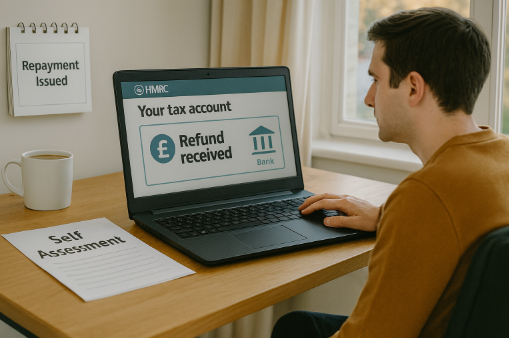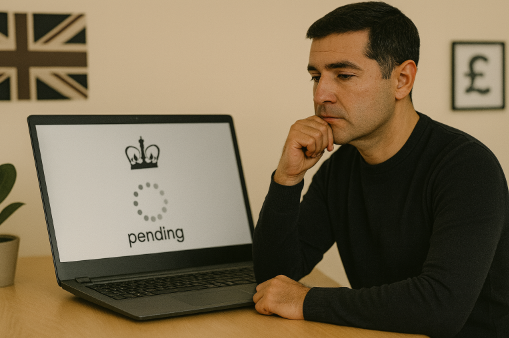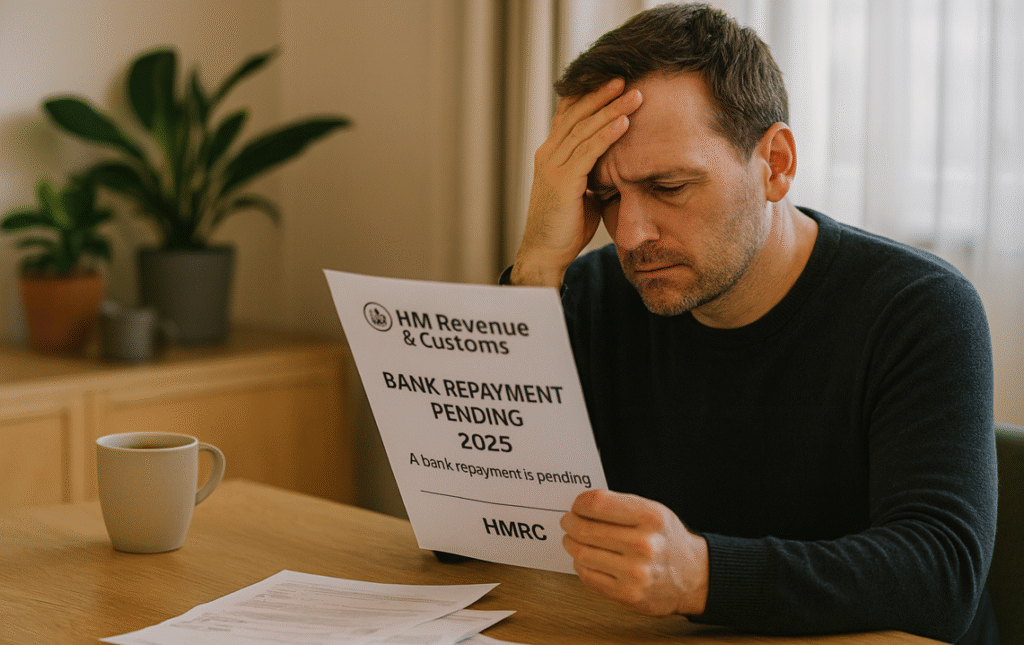Introduction
If you’ve logged into your HMRC account and spotted the status “Bank Repayment Pending”, don’t panic—it just means the refund has been approved but hasn’t quite landed in your account yet. In 2025, this status is more relevant than ever, thanks to delays caused by industrial action, service backlogs, and evolving digital changes.
You’ll notice this post includes key search terms like HMRC bank repayment pending 2025, tax refund delays, PAYE refund delay, service backlog HMRC, and fraud checks—naturally woven in to help both readers and search engines.
What Does “Bank Repayment Pending” Mean in the HMRC Context?
This status is HMRC’s way of telling you that your refund has been approved and the payment has been initiated—but it hasn’t arrived in your bank yet. Essentially:
-
HM Revenue and Customs has calculated the amount and issued instructions to transfer.
-
The funds are now in the hands of either HMRC’s banking provider or your own bank, depending on processing.
-
If all systems are smooth, this usually takes a few days—but in 2025, that timeline is stretched.
Consider it the halfway point: approval done, but clearance still in progress.
Why Is My HMRC Refund Showing as Bank Repayment Pending?

What Is the Standard Processing Time for an HMRC Refund?
Typically, if your return is filed online via Self‑Assessment or PAYE, refunds appear in 5–10 working days.
-
Online refunds are faster—most arrive within 1–2 weeks.
-
But if you submitted by post or during peak tax season, expect 4–6 weeks or longer.
Why the difference? Online methods are faster because digital systems process your claim immediately, whereas paper forms need manual checks, verification, data entry, and are more likely to hit delays at peak times.
What Causes Security or Systemic Checks?
- Fraud prevention kicks in when HMRC detects irregularities—recent updates to your bank info, high refund amounts, or unusual filing patterns can trigger automated checks.
- Security holding periods: In many cases, refunds are held for up to 6 weeks. HMRC may ask for extra docs—ID, bank statements, or proof of earnings, particularly in high‑risk areas like CIS.
- Real-world glitches: One accountant noted “false repayments” triggered by an Easter IT bug—all team members marked as “pending” but not genuine. These need manual clean‑up.
What Is the Impact of Industrial Action?
-
HMRC has faced significant industrial action beginning in December 2024, extended through 6 June 2025.
-
This involved over 30,000 civil servants, affecting core services such as PAYE, CIS, and helplines.
-
Call handling, refund processing, and response times all slowed down significantly.
How Are Customer Complaints and Service Capacity Affecting Delays?
-
-
In 2024–25, they handled 40,009 complaints—double what they managed just a few years earlier.
-
Average call wait: Over 23 minutes. Worse, nearly 44,000 calls were cut off after 70 minutes without warning or callback.
-
Though HMRC claims an 80% satisfaction rate, watchdog groups say service quality is degrading and taxpayer confidence is eroding.
-
Longer wait times + overwhelmed staff = slower refunds and calmer patience running thin
How Long Should You Typically Wait for an HMRC Bank Repayment?
| Scenario | Expected Timeline |
|---|---|
| Online Self‑Assessment refund | 1–2 weeks (5–10 working days) |
| Paper-based or postal filing | 4–6 weeks or more |
| Fraud prevention or recent payment checks | Up to 6 weeks (sometimes even a few months) |
| Industrial action/backlog cases | 4+ months in some cases |
Timelines are working-day estimates and may stretch during busy periods.
What Should You Do If Your HMRC Bank Repayment Is Still Pending?

Monitoring and Waiting Smarter
-
It’s a frustrating wait—but delays are often procedural. Use your HMRC online account to check the status regularly.
When to Contact HMRC
-
If the status remains as “pending” after 10 working days, or certainly after 4–6 weeks, it’s time to act.
-
Use HMRC’s “Check when you can expect a reply” tool to see where your request is in the queue.
What to Prepare When Contacting HMRC
Have this ready:
-
Your Unique Taxpayer Reference (UTR)
-
Submission date
-
Type of return (Self‑Assessment, PAYE, CIS)
-
Bank account number and sort code
Be calm but assertive—ask if your claim is flagged, if identity verification is needed, or when you might expect payment.
What Could You Do to Avoid Future Delays?

-
File early and online—getting ahead of the end-of-year rush gives HMRC less backlog to deal with.
-
Double-check your bank details—even a single digit error can delay or block payment.
-
Keep personal records up to date—address, name, or banking changes should be updated well before a refund is due.
-
Watch for letter-based refunds like P800 notices from HMRC—they can allow for quicker refunds if actioned promptly.
When Do Delays Extend Beyond the Usual Timeframe?
-
In 2025, some PAYE and CIS refunds are taking more than 4 months to process. This is especially true for claims submitted in the spring; some are only expected to complete by August.
-
HMRC staff shortages and industrial action are key drivers behind these extended delays.
“Refunds that used to take a few weeks are now extending to well over four months—especially in PAYE and CIS cases. Industrial action and a deep backlog are to blame.”
— Equilibrium Accountants, quoted in The Guardian
Conclusion
Seeing “Bank Repayment Pending” on your HMRC account means you’re somewhere between approval and money in the bank. Ideally, refunds arrive within 1–2 weeks—but in 2025, expect longer waits due to fraud prevention, industrial action, staffing issues, and service backlogs.
You can stay proactive by:
-
Filing early and online
-
Checking and updating bank details
-
Using HMRC’s online account tools
-
Keeping documentation ready
-
Reaching out only when delays are unreasonable
With knowledge, patience, and the right steps, you’ll manage the wait more confidently. You’re not alone—and it doesn’t have to be a mystery.
FAQs
Why is HMRC taking so long to process refunds in 2025?
Staff shortages, industrial strike action, fraud checks, system backlogs, and slower customer service are all contributing. Some refunds now take over four months.
What exactly does “bank repayment pending” mean?
It means your claim is approved, and HMRC has started the payment—they just can’t control how long it takes to clear through the banks.
When should I contact HMRC?
If you’ve been pending for 10 working days—or better yet, after 4–6 weeks—it’s totally reasonable to get in touch. Use their time‑check tool first.
Will correcting mistakes make a difference?
Absolutely. Simple errors like a digit in your sort code or filing during a busy period can delay the process. Double-checking details early can save weeks of waiting.
What if I’m struggling for cash flow while waiting?
Keep using HMRC’s online tools to check progress. Contact them if it’s an urgent issue. If you’re a business, discuss payment arrangements or cashflow planning with your accountant—delays are widespread this year.
I’m Laura Wilson, a passionate blogger and content creator with a deep interest in business, finance, and entrepreneurship. I’ve had the opportunity to write for several premium blogs, sharing insights & practical advice for individuals & small businesses. I’m the founder and publisher of ukbusinessmag.co.uk, where I focus on creating valuable, easy-to-understand content to help UK startups & SMEs grow.



